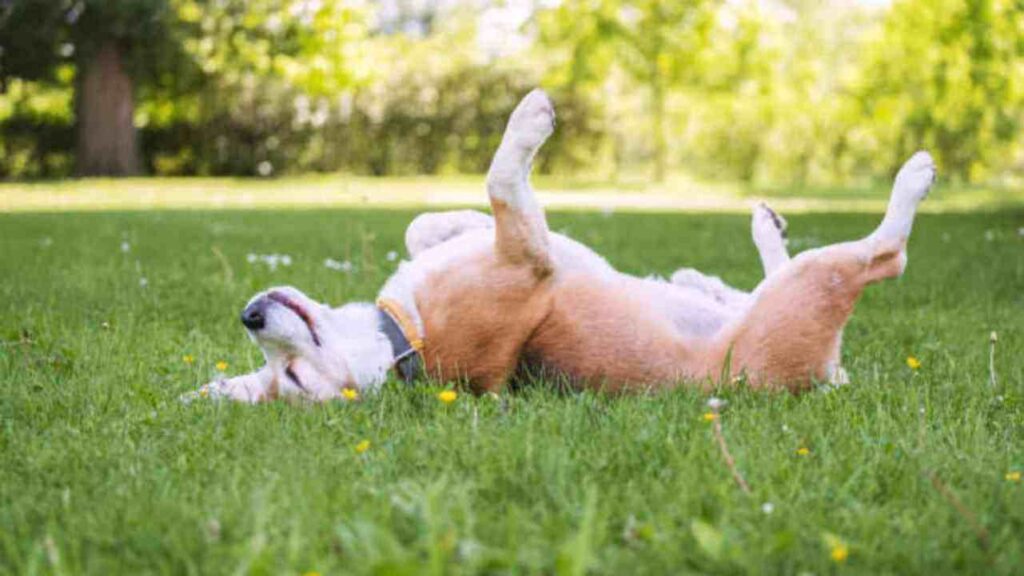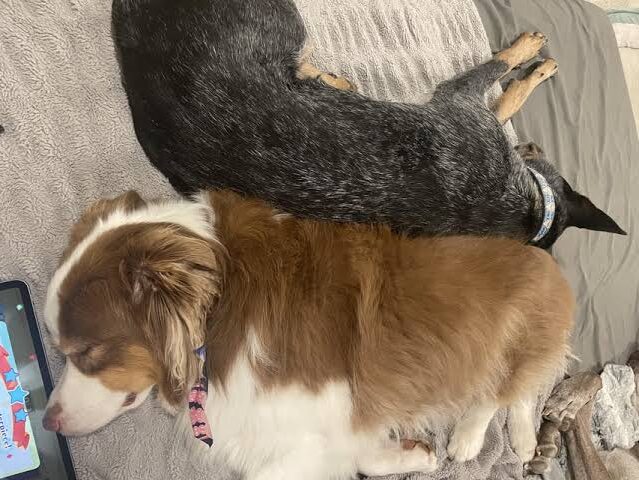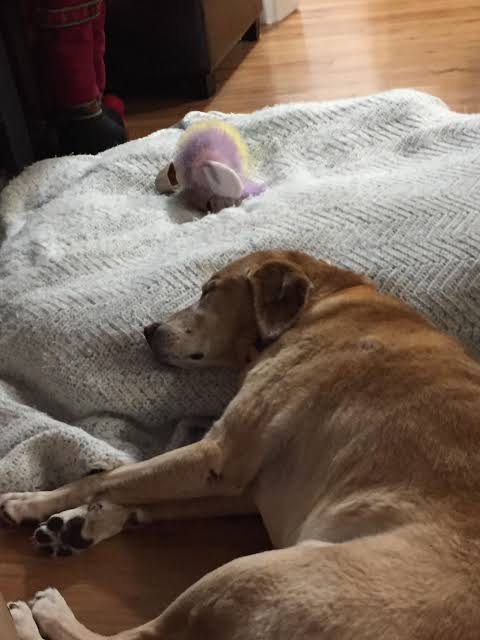If you are a dog parent, you may have noticed that your dog sleeps in a variety of positions. Often, some of these positions are quite unusual. I sometimes feel like my dog is the only one who sleeps like that, or that every dog sleeps like this. If you have a pet dog, you will notice every single thing your dog does, even the position in which they sleep. But did you know that sleeping positions have different meanings? Generally, when you are feeling too tired, you don’t consciously choose which position you will sleep in. The same thing happens with dogs. If they are too tired, you can often tell by their sleeping position. Sometimes, a dog wants to remain alert while taking a short nap, which is why they choose certain sleeping positions. In this article, we will explore the meanings behind my dog’s sleeping positions.
Dog sleeping positions meaning
Here we have mentioned all the popular sleeping position of dogs and their meanings.
1.The Donut :

When a dog sleeps curled tightly into a ball, it’s called the “Donut” position. This behavior is deeply rooted in a dog’s instincts. Curling up helps conserve body heat, which is especially important for dogs in colder environments or during cooler seasons. It’s a natural method of keeping themselves warm and comfortable. Additionally, the donut shape offers a feeling of protection — by curling up, dogs shield their vital organs, a behavior inherited from their wild ancestors who needed to defend themselves while sleeping.
Beyond physical reasons, the donut position can also be emotional. Dogs might sleep curled up when they seek a greater sense of security. It’s a sign that they are trying to feel safe and minimize exposure to anything they might perceive as a threat. Even in loving homes, dogs sometimes instinctively seek this comfort. Some dogs simply find it the coziest and most natural way to sleep, just as humans have preferred sleeping positions.
In general, if your dog sleeps in a donut, it is not a cause for concern unless it’s a sudden behavioral change or combined with signs of anxiety or illness. Understanding this position helps owners create an even more comforting environment for their pets.
Your Role and What You Can Do:
- Provide warmth: Offer a cozy bed, a soft blanket, and a warm, draft-free sleeping spot.
- Offer emotional security: Maintain a calm, consistent home environment to help your dog feel safe and relaxed.
- Respect their sleeping space: Avoid disturbing your dog when they are curled up, allowing them to rest undisturbed.
- Observe behavior changes: If your dog suddenly changes sleeping styles or seems unusually stressed, monitor closely and consult a vet if necessary.
- Enhance comfort: Add familiar scents like your old T-shirt to their bed for extra comfort and reassurance.
- Celebrate their instincts: Understand that curling up is natural and shows your dog’s smart instinct for warmth and security — it’s not something you need to fix!
2. Sphinx / Lion Position:

When a dog sleeps in the Sphinx or Lion position — front legs stretched forward, chest upright, and head resting gently or held alert — it often signals a state of light rest rather than deep sleep. In this position, dogs are relaxed but ready to move at a moment’s notice. This pose allows them to jump up quickly if needed, a trait inherited from their wild ancestors who had to stay alert for predators or opportunities. It’s a semi-alert posture, blending comfort with quick readiness.
The Sphinx position also shows trust in the environment but paired with a hint of cautious awareness. It’s common in dogs who are resting in new environments, waiting for something exciting (like food or a visitor), or simply not yet fully committed to deep sleep. Puppies and energetic young dogs often use this position when they don’t want to miss out on anything happening around them.
Occasionally, a dog resting like a sphinx might also be regulating body temperature — lying flat helps them stay cool, especially on cool tiles or floors. Overall, it’s a healthy and natural pose, reflecting a dog’s balance between relaxation and alertness.
Your Role and What You Can Do:
- Create a calm environment: Encourage your dog to relax fully by reducing sudden loud noises or distractions.
- Offer a comfortable resting area: Soft mats or beds help them ease from light rest into deeper sleep if they choose.
- Respect their alertness: Understand that your dog might prefer to stay lightly alert — let them set their own pace without forcing them to sleep deeper.
- Watch for patterns: If your dog often stays in this position and never fully relaxes, it could hint at underlying anxiety — monitor and consult a vet if needed.
- Celebrate their instincts: Recognize that this posture shows your dog’s natural intelligence and readiness, not fear or discomfort.
- Provide reassurance: Sit nearby or speak softly to help your dog feel even safer to relax deeper if they want.
3. Side Sleeper :

When a dog sleeps on its side, completely stretched out with legs extended and body relaxed, it’s known as the Side Sleeper position. This is one of the most comfortable and trusting sleeping postures a dog can have. It shows that the dog feels safe, relaxed, and completely secure in its environment. In this position, the dog’s vital organs are exposed, indicating that they do not feel threatened and are in a deep, restful sleep. It’s a sign of a happy, confident dog that trusts the people and animals around them.
Dogs who sleep on their side often slip into the deepest stages of sleep, including REM sleep, where dreaming happens. Puppies, senior dogs, and dogs in loving homes commonly adopt this posture. It’s also an indication that the dog is physically comfortable — no joint stiffness or pain is preventing them from stretching out fully.
However, if a dog usually sleeps in a curled or protective position and suddenly becomes a side sleeper, it might mean they are growing more comfortable and confident over time. The side sleeper position reflects both physical comfort and emotional security, making it a very positive sign for dog owners to observe.
Your Role and What You Can Do:
- Provide a cozy, supportive bed: Ensure your dog has enough space and soft bedding to stretch out fully without constraint.
- Maintain a calm home environment: Keep their space peaceful to encourage deep, healthy sleep cycles.
- Celebrate the trust: Understand that your dog choosing this position around you is a huge sign of their deep trust and love.
- Watch for health signs: Stretching out comfortably also indicates good joint health — continue regular vet checkups to maintain it.
- Allow uninterrupted rest: Try not to disturb your dog when they are in deep side sleep, as they could be dreaming or fully recharging.
- Capture the moment: Side sleepers often look incredibly adorable — it’s a perfect time to quietly snap a memory (without waking them up)!
4. Cuddling :

When a dog sleeps while cuddling either with their owner, another pet, or even snuggled against a pillow or blanket, it speaks volumes about their emotional needs and feelings. Cuddling is a strong sign of affection, love, and deep trust. Dogs are naturally pack animals, and close physical contact helps them feel bonded and secure. By cuddling, they are expressing their desire for connection, warmth, and emotional reassurance. It shows they see you (or whoever they cuddle) as part of their family — their safe zone.
Cuddling while sleeping can also be a behavior carried from puppyhood, where they would pile up with their littermates for warmth and safety. Adult dogs that cuddle while sleeping are often those who have a deep bond with their humans and feel completely safe in their presence. Some dogs might also cuddle when they are feeling vulnerable, anxious, or simply want comfort during rest.
This behavior can vary depending on the dog’s personality; some naturally crave more physical affection than others. If your dog cuddles with you, it’s a beautiful indicator that you have established a strong, trusting relationship, and they are seeking your companionship even during their most vulnerable moments — sleep.
Your Role and What You Can Do:
- Offer gentle comfort: Let your dog cuddle if they initiate it; don’t force them if they’re not in the mood.
- Provide cozy spaces: Create soft, inviting resting areas where your dog can snuggle freely.
- Respect boundaries: Always allow your dog to move away if they need more personal space.
- Give positive reinforcement: Gently pet or speak to your dog when they cuddle to strengthen the bond.
- Watch for emotional needs: Cuddling can sometimes signal that your dog needs extra reassurance, especially during storms or stressful events.
- Cherish the moment: Understand that not every dog is naturally cuddly — if yours is, it’s a special expression of trust and love.
5. Superman :

When a dog sleeps flat on their stomach with their legs stretched out behind and in front of them — almost like they are flying through the air — it’s called the Superman position. This adorable and energetic pose is often a sign that the dog is comfortable, playful, and relaxed, but also ready to spring into action at any moment. Dogs, especially puppies and young adults, tend to adopt this position when they are resting but still want to stay engaged with their surroundings. It shows a balance between needing a quick rest and staying alert for the next round of play or activity.
The Superman pose is particularly common in happy, well-exercised dogs. It also allows them to cool off by having their belly pressed against a cool surface like tile or hardwood floors. In warmer environments, you may notice your dog choosing this position more often to regulate their body temperature. Overall, a dog sleeping in the Superman position shows that they are feeling safe, content, and energetic. They are relaxed enough to nap, but they don’t intend to sleep deeply or for long periods — they’re simply recharging for more fun!
Your Role and What You Can Do:
- Provide cool, comfy surfaces: Make sure your dog has access to cool floors or mats, especially on warm days.
- Encourage playtime: A dog that sleeps like this is usually playful — continue engaging them with games and activities.
- Allow short naps: Respect their need for quick rest periods during active play sessions.
- Keep an eye on energy levels: If they’re often lying like this but seem sluggish, it could signal they are tired or overheating.
- Celebrate their happiness: This position shows a happy, carefree pup — be proud of the safe environment you’ve provided!
6. On Their Back :

When a dog sleeps flat on their back with all four paws in the air, it’s a truly adorable and telling sight. This position indicates complete trust, relaxation, and security. A dog lying on their back exposes their most vulnerable areas — their stomach, chest, and throat — which they would never do unless they felt completely safe in their environment. It shows that the dog is calm, stress-free, and happy at home. They are not worried about any threats and are entirely at ease.
Additionally, sleeping on the back helps a dog cool down, as it exposes less fur-covered areas to the air. It’s common to see dogs sleep like this during warmer seasons or after an energetic play session. This position can also signify a confident personality — dogs who are self-assured and feel protected are more likely to sprawl out like this.
However, not all dogs sleep on their backs, and that’s perfectly normal too. Some may prefer other positions based on comfort or their natural instincts. But if your dog loves lying on their back, take it as a huge compliment: you’ve created a space where they feel completely loved and safe.
Your Role and What You Can Do:
- Maintain a safe, peaceful environment: Keep your home calm and free from sudden loud noises.
- Offer soft bedding: Give them comfy spaces where they feel safe sprawling out.
- Provide proper cooling: Especially on warm days, ensure the area is not too hot, helping them cool down naturally.
- Respect their comfort: Avoid startling or touching their belly suddenly while they are asleep like this.
- Celebrate their trust: Appreciate that your dog feels so secure and confident around you!
7. Burrowing :

When a dog sleeps burrowed under blankets, pillows, or tucked into cozy spaces, it’s a strong sign of their instinctual need for security, comfort, and warmth. Burrowing is a deeply rooted behavior from their wild ancestors, who would dig into the ground or seek enclosed spaces to protect themselves from predators and harsh weather. Even today, domestic dogs retain this natural instinct, and when they burrow, it shows they are seeking a safe, snug environment.
Burrowing can also indicate a need for emotional comfort. Dogs may burrow when they are feeling a little anxious, wanting to be closer to their owners, or simply craving a more cocooned sleeping experience. It’s very common in smaller breeds and dogs with thin coats, who feel the cold more acutely. Some dogs burrow to create a little “den” — a private, secure space that helps them relax deeply.
If your dog loves to burrow, it’s not a cause for concern. Instead, it’s a clear sign they are acting out a natural, comforting behavior. It means they trust you enough to create their “safe cave” within your home. Encouraging this behavior can enhance their sense of security and happiness.
Your Role and What You Can Do:
- Provide cozy spaces: Offer blankets, dog beds with sides, or designated safe spots for burrowing.
- Keep them warm: Especially in colder months, make sure they have access to soft, warm materials.
- Respect their space: Allow them to burrow without constantly disturbing them — it’s their way of feeling secure.
- Observe for anxiety signs: If burrowing becomes obsessive, it might indicate stress — offer extra comfort or consult a vet if needed.
- Celebrate their instincts: Understand that burrowing is a healthy, natural behavior that signals your dog feels at home with you.
8. Back to Back :

When a dog chooses to sleep back-to-back with you or another pet, it’s a powerful sign of trust, bonding, and affection. In the wild, dogs and wolves often sleep huddled together, back-to-back, to protect each other and stay warm. This ancient instinct still lives in domestic dogs today. By resting their back against yours, your dog is saying, “I trust you to protect me while I sleep.” It’s a gesture that speaks volumes about your bond.
Back-to-back sleeping shows deep emotional connection. Your dog feels safe enough to enter a vulnerable, relaxed state while touching you. It’s a way of offering and seeking companionship. This position is very common among dogs that are closely bonded with their owners, other dogs in the household, or even other pets like cats.
It also signals a strong pack mentality — your dog sees you as part of their trusted circle. Sleeping this way strengthens your emotional bond over time, reassuring your dog that you are their family. If your dog regularly sleeps back-to-back with you, it’s one of the purest expressions of loyalty, affection, and security.
Your Role and What You Can Do:
- Accept their closeness: Recognize it as a huge sign of love and emotional trust.
- Provide a safe, quiet sleeping environment: Support their need for secure, cozy spaces where they can relax fully.
- Stay calm and steady: Your dog depends on your calm presence, especially during sleep.
- Strengthen the bond: Offer gentle pets or cuddles when they seek closeness, reinforcing their sense of safety.
- Respect their space when needed: If they move slightly away, don’t force extra closeness — let them decide how they feel most comfortable.
- Celebrate your connection: Understand that a back-to-back sleeper truly sees you as family.
9. Raised Head :

When a dog sleeps with its head raised, either propped up on a paw, a cushion, or even a piece of furniture, it often signals alertness and awareness even during rest. Unlike fully relaxed sleeping positions like “on their back” or “cuddling,” the raised head posture suggests that the dog is still partially on guard. They are resting but keeping themselves ready to react to sounds, smells, or any sudden movement. It’s a half-relaxed, half-vigilant state that dogs often adopt when they want to nap lightly but remain attentive to their environment.
Dogs may choose this position when they are in new surroundings, when visitors are around, or when they are naturally more protective or responsible over their territory and loved ones. It can also show that they are monitoring their surroundings while feeling reasonably safe — meaning they trust their environment enough to lie down but still want to be “ready” just in case.
Sometimes, dogs with breathing issues, minor congestion, or digestive discomfort may also lift their heads to feel more comfortable. In such cases, the position is more about physical comfort than vigilance.
Either way, a dog sleeping with a raised head shows a mix of caution, care, and instinctive protection.
Your Role and What You Can Do:
- Observe calmly: Watch for patterns — if your dog always sleeps this way, it could suggest a protective instinct or mild health discomfort.
- Create a safe, peaceful environment: Reduce loud noises, sudden movements, and keep the surroundings calm to encourage deeper, more relaxed sleep.
- Offer soft pillows or cushions: Providing comfy support can make raised-head sleeping more comfortable.
- Monitor for any breathing issues: If your dog frequently needs to keep their head elevated, it might be worth a gentle vet check-up.
- Respect their natural instincts: Understand that staying alert is part of their job as loyal companions.
- Reassure with presence: Your calm, trusted presence helps them feel safe enough to eventually relax fully.
10. On a Cold Surface :

When a dog chooses to sleep directly on a cold surface like tile floors, concrete, or wooden floors, it usually means they’re trying to cool down. Dogs regulate their body temperature differently from humans — they don’t sweat much, so lying on a cool surface is one of the easiest ways for them to release excess body heat and stay comfortable. This position is especially common in the warmer months or after exercise when their bodies are naturally warmer than usual.
It also shows that your dog is comfortable and practical — they instinctively seek out what feels best for their body without overthinking it. A dog sleeping on cold floors might stretch out fully to maximize the surface area touching the cool floor, helping them cool off even faster. Sometimes, even in winter, dogs with naturally thick coats or who are more heat-sensitive might still prefer cold surfaces because their bodies retain a lot of warmth.
On a behavioral level, sleeping on a cold surface often signals a dog who feels safe and unthreatened. They are confident enough in their surroundings to prioritize comfort over protection or concealment.
Your Role and What You Can Do:
- Make sure cool surfaces are safe: Ensure the floors are clean and free of sharp objects or harmful chemicals.
- Provide optional cooling mats: Especially in summer, cooling mats can offer controlled and comfortable coolness.
- Allow flexibility: Let your dog choose between warm beds and cooler floors based on their comfort.
- Monitor for overheating: If your dog seems to always seek cold surfaces excessively, it could hint at overheating issues that may need a vet’s attention.
- Ensure hydration: Always have fresh, cool water available, especially if your dog prefers cooler places.
- Respect their comfort needs: Understand that this choice is healthy and normal for many dogs and reflects good self-care instincts.
11. Sleeping on the Owner :

When a dog sleeps directly on top of their owner, it’s one of the most powerful signs of love, trust, and deep emotional bonding. Dogs are pack animals by nature, and sleeping close — or even better, on top of — their “pack leader” (you) is their way of expressing that you are their safest place. It’s not just affection; it’s about protection and security too. Your dog may feel the most secure when they are physically close to you, feeling your warmth, heartbeat, and scent, which soothes them deeply.
This behavior is also a sign of attachment and dependency. Dogs who sleep on their owners often experience a strong sense of emotional connection, sometimes even separation anxiety when apart. Puppies are especially likely to exhibit this behavior, but adult dogs who are very bonded will continue doing it throughout their lives. It can also be a way for them to claim their territory (you!) and mark you with their scent, subtly telling other pets, “this human is mine.”
For some dogs, especially rescue or anxious dogs, sleeping on their owner is a critical part of rebuilding trust and emotional healing after trauma.
Your Role and What You Can Do:
- Accept it as a compliment: Understand that your dog feels completely safe and connected with you.
- Set healthy boundaries if needed: If sleeping on you disturbs your sleep, gently guide them to sleep beside you instead.
- Provide alternative comfort: Offer soft bedding nearby that smells like you (like using a worn T-shirt) to give them security.
- Observe for separation anxiety: If they seem overly attached and anxious when apart, consider training or professional advice.
- Strengthen your bond: Regular affection, attention, and reassurance can make them feel even more emotionally secure.
- Monitor size and weight: Large dogs sleeping on top of you might be uncomfortable over time, so it’s okay to gradually transition them to cozy spaces next to you.
12. The Pancake :
When a dog sleeps flat on their side or belly, legs stretched out, looking completely relaxed and almost “flattened” against the ground — it’s known as the Pancake position. This is a very telling posture because it signals complete trust, relaxation, and security in their environment. A dog that adopts the Pancake pose is so at ease that they don’t feel the need to protect their vulnerable belly or chest. It’s often seen in dogs who are physically exhausted, extremely comfortable, or feeling emotionally safe in their surroundings.
Interestingly, the Pancake position can also suggest that your dog is in a deep, restful sleep, where their body is fully relaxed. Puppies, in particular, tend to flop down like pancakes after an intense play session or exploring, signaling that they’ve expended all their energy and feel totally safe to recharge.
In some cases, older dogs or those recovering from illness or stress might also prefer the Pancake position because it allows their muscles to fully relax without pressure on their joints. It’s a positive sign that they are comfortable and feel no need to stay on high alert.
Your Role and What You Can Do:
- Create a peaceful environment: Keep noise, lighting, and disturbances minimal so they can rest deeply.
- Ensure their comfort: Offer soft beds or supportive surfaces to make lying flat easier, especially for senior dogs.
- Respect their rest: When they’re in this deep state, avoid sudden movements or loud noises that might startle them.
- Watch for overexertion: If they “pancake” too often after activity, ensure they’re not overdoing physical play.
- Celebrate the trust: Know that your dog feels totally safe with you, and continue nurturing that bond with love and gentle care.
- Monitor health if necessary: If they seem excessively lethargic or show other signs of discomfort, consult your vet to rule out health concerns.
13. The Sprawl :
When a dog sleeps sprawled out with their legs stretched in different directions, usually belly down and limbs flopped outward, it’s called The Sprawl. This is one of the most adorable and relaxed positions dogs can take. It usually indicates that your dog feels safe, secure, and completely at ease in their environment. Unlike the more tightly curled Donut position or the protective Sphinx pose, The Sprawl shows a dog that’s not worried about needing to react quickly. Their exposed posture signals full trust in their surroundings.
The Sprawl is also very common after a lot of physical activity, like running, playing, or long walks. Dogs naturally sprawl out to cool down by exposing their belly and inner limbs to the air, which helps regulate body temperature. Puppies and young energetic dogs often favor this position because it allows them to crash into sleep immediately after play without worrying about getting up quickly.
Occasionally, dogs that sleep like this may be trying to stretch out sore muscles, especially after an active day. It’s a sign of healthy exhaustion and satisfaction — a very positive behavior when seen in a loving, safe environment.
Your Role and What You Can Do:
- Provide a cool, open space: Ensure your dog has room to stretch out freely without bumping into furniture or tight corners.
- Offer supportive flooring: A soft mat or cool tiles work great if your dog sprawls to cool down after exercise.
- Respect their space: Let them rest peacefully without interrupting when they are in such a relaxed posture.
- Recognize healthy habits: Celebrate that they feel safe enough to sleep in such a vulnerable way.
- Keep an eye after intense exercise: If sprawling is combined with excessive panting or signs of overheating, make sure they are cooling down safely.
- Show appreciation: Their comfort is a reflection of the secure, loving environment you’ve created!
14. The Fox Sit Sleep :
The Fox Sit Sleep is a charming and slightly unusual sleeping position where a dog sits on their haunches with their body curled tightly, their head often tucked down or resting on their paws, and their tail wrapped around their body—similar to how a fox curls up in the wild. This posture is not just cute; it serves practical purposes too.
When a dog sleeps in the Fox Sit Sleep position, it usually signals comfort mixed with a need for warmth and protection. Tucking themselves up conserves body heat and shields their vital organs, suggesting a blend of feeling secure but still slightly cautious. This position is common in cooler environments or when dogs are feeling a bit uncertain or wanting to be ready to move if needed. Dogs may instinctively adopt this pose in new places or when they are emotionally or physically tired but still alert.
It can also be a habitual posture for breeds with strong survival instincts. Seeing your dog sleep like this is generally a good sign that they are comfortable but maintaining a small degree of readiness, showing a nice balance between relaxation and natural instinct.
Your Role and What You Can Do:
- Offer a warm, cozy space: Provide soft bedding or blankets, especially during cooler weather.
- Make them feel safe: Reinforce feelings of safety so that over time, they may relax into even more open, vulnerable sleeping positions.
- Observe environmental factors: If they often curl up like this, check if the room is too cold or if they need a more secure sleeping area.
- Let them rest peacefully: Respect their need for comfort and slight protection when they choose this sleep posture.
- Provide reassurance: Gentle petting or calming scents can help them feel even more at ease over time.
- Celebrate trust: This position shows they are happy but still tuned into their natural instincts—a beautiful balance of trust and caution.
15. The Half-Snooze :
The “Half-Snooze” is a dog sleeping position where the dog appears to be in a light, semi-conscious state. It is characterized by the dog lying on its side, stomach, or back, often with its limbs in a relaxed position, either extended or tucked. In this posture, the dog may have one eye partially open or its eyelids half-closed. The Half-Snooze position typically indicates that the dog is not in a deep sleep but is rather in a restful state while maintaining a level of alertness. This sleep state allows the dog to remain aware of its surroundings and be ready to react if needed. Dogs in this position might be more sensitive to sounds or movements around them, and they can quickly wake up if there’s a change in their environment. It’s a natural behavior that reflects the dog’s need for rest while staying vigilant, often seen in dogs that feel secure but still want to remain partially alert, whether due to their instincts or their environment.
What is Your Role :
- Provide a Safe Environment: Ensure the dog’s resting space is quiet, secure, and free from potential disturbances.
- Avoid Sudden Movements: Respect the dog’s light sleep by avoiding loud noises or sudden gestures that might disrupt their rest.
- Allow Peaceful Rest: Give the dog time and space to enjoy its half-sleep state without being constantly disturbed.
- Observe for Signs of Discomfort: Watch for any signs of anxiety or restlessness, as the dog may need more comfort or a change in surroundings.
- Maintain Calmness: Keep a calm environment, as heightened activity or stress can prevent the dog from relaxing fully.
- Respect Boundaries: Even though the dog is in a restful state, it’s important not to intrude too much or make the dog feel overstimulated.
16. The Cave Sleeper :
The “Cave Sleeper” position refers to when a dog curls up tightly in a ball, often with its back against a surface like a wall or furniture, and its body tucked closely to itself. This position mimics the way wild dogs would burrow into a den or cave to feel safe and secure. The dog’s tail may be wrapped around its body, and its head might be tucked into its paws or against its chest. The Cave Sleeper position is often seen in dogs that seek warmth and security. By curling up, the dog reduces its exposed surface area, which helps conserve body heat and makes them feel protected. This position also allows the dog to feel as though it has control over its environment, minimizing any vulnerabilities while resting. It’s an instinctive behavior rooted in survival instincts, especially for dogs that are more cautious or prone to anxiety.
What is Your Role :
- Provide a Cozy Spot: Ensure the dog has a warm, comfortable, and quiet place to rest where it feels secure.
- Respect Space and Security: Avoid disturbing the dog while it’s in this position, as it may indicate a need for personal space or comfort.
- Create a Safe Environment: Minimize potential threats or stressors around the dog to enhance its feeling of security.
- Watch for Overheating: Since the dog curls up tightly, ensure it doesn’t get too hot in this position, especially in warm environments.
- Respect the Dog’s Need for Rest: Allow the dog to remain undisturbed, as this position often reflects the dog’s need to feel safe and relaxed.
17. The T-Rex :
The “T-Rex” sleeping position is characterized by a dog lying on its stomach with its limbs tucked under its body in a manner similar to the short, stumpy legs of a T-Rex dinosaur. The dog’s body might be fully extended or slightly crouched, with the front paws folded beneath the chest and the back legs tucked in tight. In this position, the dog appears alert but relaxed, suggesting that they are in a light sleep state while still feeling somewhat active. The T-Rex position is often seen in dogs that are energetic or playful by nature, as it allows them to remain comfortable while still having the ability to spring into action quickly if needed. Dogs in this position typically don’t appear to be in a deep sleep, but instead in a light rest or nap. The posture is often an indicator that the dog is well-rested enough to relax but is still mentally prepared for action.
What is Your Role :
- Provide a Comfortable Resting Place: Ensure the dog has a soft, supportive surface to lie on, allowing it to relax without feeling constrained.
- Avoid Disturbing the Dog: Since the dog may not be in a deep sleep, avoid making sudden noises or movements that could startle it awake.
- Encourage Relaxation: Offer a calm environment where the dog can rest without feeling overstimulated or distracted.
- Respect the Dog’s Alertness: Be mindful that the dog may remain partially alert, so avoid doing anything that could cause unnecessary stress or anxiety.
- Ensure Safety: Make sure the dog’s resting space is safe and free from any potential hazards that could disrupt its rest or cause discomfort.
18. The Head Hider :
The “Head Hider” sleeping position occurs when a dog hides its head, either by tucking it under its paws, burying it into a blanket, or pressing it against a wall or other surface. This position indicates that the dog is seeking comfort and security, often as a response to feeling vulnerable or wanting to shield itself from potential threats. It is an instinctual behavior that mimics how wild dogs might burrow or hide their faces to protect their sensitive eyes and nose from predators or harsh weather. The Head Hider position can also suggest that the dog is looking for warmth or reassurance, as it often accompanies dogs who are more anxious or sensitive. By hiding its head, the dog may feel less exposed and more at ease, allowing it to relax more fully during sleep.
What is Your Role :
- Provide a Secure, Quiet Space: Ensure the dog has a safe, calm, and undisturbed environment where it can rest without feeling exposed.
- Respect the Need for Comfort: If the dog hides its head, it likely indicates a need for comfort or security. Allow the dog to continue in this position without disturbing it.
- Provide Soft Bedding: Make sure the dog has access to soft bedding or blankets that it can burrow into for added comfort and warmth.
- Minimize Stress: Avoid loud noises, sudden movements, or stressful situations that could cause the dog to feel more anxious or uncomfortable.
- Observe for Anxiety: If the dog frequently hides its head, observe whether it’s related to anxiety or discomfort and consider providing extra reassurance or a more secure resting space.
- Ensure the Dog’s Safety: Ensure that the dog’s face isn’t obstructed in a way that could hinder breathing or cause discomfort.
19. The Stiff Legs :
The “Stiff Legs” sleeping position refers to when a dog sleeps with its legs fully extended and stiff, often lying on its side or stomach. In this position, the dog’s body appears rigid, with all four limbs stretched out, and the dog may look as though it is in a “frozen” or upright posture. This position is typically seen in dogs that feel completely relaxed and confident in their environment, allowing them to rest in a fully extended, comfortable posture. The Stiff Legs position can also indicate that the dog is in a deep sleep and fully relaxed, as it’s uncommon for dogs to sleep in such a rigid position unless they are secure in their surroundings. While it suggests relaxation, it may also signal that the dog is physically tired or drained from activity and is resting deeply to recover.
What is Your Role :
- Ensure a Comfortable Surface: Provide a soft and supportive surface for the dog to sleep on, as this position requires full extension of the body.
- Allow Peaceful Rest: Allow the dog to rest undisturbed, as the Stiff Legs position indicates deep relaxation.
- Respect the Dog’s Space: Avoid disturbing the dog, as it may be in a deep, restorative sleep that helps it recover from physical exertion.
- Observe for Any Signs of Discomfort: If the dog frequently sleeps in this position and seems uncomfortable or stiff when waking, it might be worth considering if the dog has any muscle or joint issues.
- Provide a Safe and Secure Environment: Ensure the dog’s surroundings are free from distractions or potential threats, so the dog can rest fully and securely.
20. The Airplane Ears :
The “Airplane Ears” sleeping position refers to when a dog lies on its back with its ears stretched out to the sides, resembling airplane wings. This position typically involves the dog being in a fully relaxed state, with its body exposed and often its legs spread out in a carefree manner. The ears, being extended outward, create the visual of airplane wings, giving the position its name. Dogs in this position are usually in a deep, contented sleep, completely trusting their environment. The Airplane Ears position suggests that the dog is not only comfortable but also feeling secure and confident enough to expose its most vulnerable areas, such as its belly and ears. This position is common in dogs that are very relaxed and have a strong bond with their owners, as they feel safe enough to rest in a fully exposed posture.
What is Your Role in the Airplane Ears Position:
- Provide a Comfortable, Safe Space: Ensure the dog has a cozy, quiet area to lie down without interruptions, as this position indicates the dog is in a deep, peaceful rest.
- Avoid Disturbing the Dog: Since the dog is in a relaxed state, avoid sudden movements or loud noises that could disrupt its peaceful sleep.
- Observe for Signs of Relaxation: If the dog is consistently using this position, it’s a good sign that the dog is feeling secure and content. Continue to maintain a calm, safe environment.
- Ensure the Dog’s Comfort: Make sure the resting area is soft and free of hard surfaces that could cause discomfort while the dog is in this vulnerable position.
- Respect the Dog’s Trust: Since the dog is exposing its belly and ears, it’s important to respect its trust and allow it to rest without interference, as this position signals complete comfort and security.
Why You Should Know Your Dog’s Sleeping Positions Meaning
We all know that dogs cannot speak like human beings. Therefore, if something happens to your dog and it is feeling sick, it is your responsibility to understand its behavior. The behavior of a healthy dog and that of an unhealthy dog is different. When a dog starts feeling unwell, its behavior also changes; sometimes, it will even try to indicate that it is not feeling well. This is called body language. Not everything can be expressed through spoken language. When someone cannot speak or we do not understand their language, we use body language to communicate.
That’s how we can interpret symptoms to understand what is going on if your dog is healthy or if something is wrong. Monitoring your dog’s sleeping position and style can help you understand its health condition. Is your dog stressed, afraid of something, or is everything okay? It all depends on your ability to understand your dog, as they cannot directly communicate with you. They cannot come to you and say they are not feeling well or that they are afraid of something. Some dogs are clever enough to give signs to their owners that they are feeling uncomfortable, but not all dogs are that adept. In the case of smaller breeds, they might struggle to express their feelings to humans.
Therefore, it is your responsibility to understand your dog’s body language, including its sleeping position, which can tell you a lot about its current situation. You can use the meaning of your dog’s sleeping position to gauge its health and understand how your dog is feeling overall.







